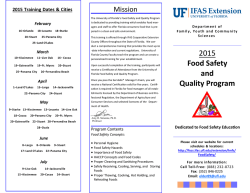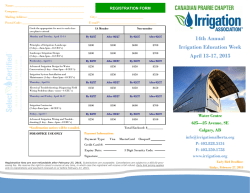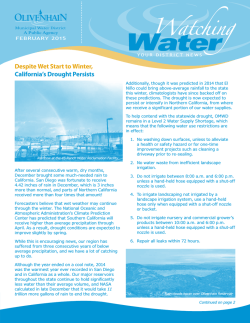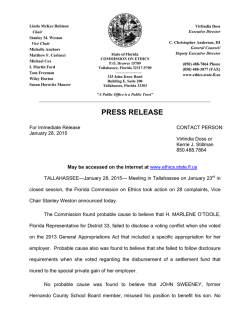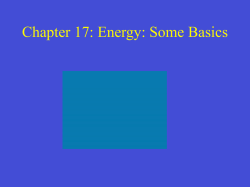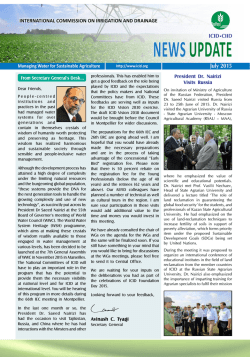
View/Open - AgEcon Search
Price- and Non-Price Water Demand Management Strategies for Water Utilities Serhat Asci1 Research Fellow E-mail: [email protected] Tatiana Borisova2 Assistant Professor Michael D. Dukes3 Professor 1 Agricultural Business Center, California State University, Fresno 2 Food and Resource Economics Department, 3 Agricultural and Biological Engineering Department, University of Florida Selected Paper prepared for presentation at the Southern Agricultural Economics Association’s 2015 Annual Meeting, Atlanta, Georgia, January 31-February 3, 2015 Copyright 2015 by Serhat Asci, Tatiana Borisova, and Michael D Dukes. All rights reserved. Readers may make verbatim copies of this document for non-commercial purposes by any means, provided that this copyright notice appears on all such copies. Price- and Non-Price Water Demand Management Strategies for Water Utilities Serhat Asci, Tatiana Borisova, Michael D. Dukes1 1 The authors are (respectively): Research Fellow in Agricultural Business Center, California State University, Fresno, Assistant Professor in the Food and Resource Economics Department, University of Florida and Professor in Agricultural and Biological Engineering Department, University of Florida Abstract Florida’s freshwater withdrawals for public water supply are the fourth largest in the U.S. (Kenny et al., 2009). Groundwater is the primary freshwater source, and given reductions in aquifer levels, water suppliers have been developing price- and non-price strategies to encourage residential water conservation. This study estimates price and income water demand elasticities for high water use residential properties in Central Florida, and compares the effectiveness of conservation pricing and irrigation controller installation in curbing residential water use. Our panel dataset includes monthly water use for 180 properties for January 2003 ̶ May 2009 (11,903 observations). Three stage least square (3SLS) technique is used to estimate average price and income elasticity, while property-level gross irrigation requirements account for weather effects on outdoor water use. Given alternative estimation techniques, the income elasticity is 0.07 and the price elasticity ranges from -0.11 to -0.13. Based on existing literature (Boyer and Dukes, 2014), smart irrigation controller installation results in average 3.5 KGA/month water use reduction. The same water use reduction is achieved by 170% water price increase that is currently politically infeasible. However, moderate price increase can incentivize installation of irrigation controllers by reducing their payback periods. Keywords: Residential water demand, non-price conservation, smart irrigation controller. 1 Introduction Water withdrawals for public water supply in Florida are the fourth largest in the nation (Kenny et al. 2009). Central Florida specifically has experienced a significant population increase in recent years, driving up water demands. The population is projected to continue growing, while the level of aquifer that supplies most of the water for the region has been declining. To address the projected shortages of water supplies, the Central Florida Coordination Area (CFCA) was created (CFWI 2004; SWFWMD 2012), and a cap on groundwater withdrawals was set to limit withdrawals to the levels of 2013 water demands. No new water withdrawal permits are allowed unless supplemental water supplies are committed to meet additional demands (SWFWMD 2012). Water conservation has been identified as a low-cost alternative for meeting part of the growing water demands while protecting groundwater resources. The county evaluated in this study is one of counties in Central Florida, and has one of the largest water utility in Central Florida, serving a population more than 500,000. Central Florida has a ground water withdrawals level of about 250 million gallons per day from the aquifer, which is one of the highest in the state of Florida (USGS 2010). A significant portion of statewide residential water use is applied irrigation for (Figure landscape 1) (e.g., Heaney et al. 1998, Southwest Florida Water Management District, undated). To residential water Figure 1. Residential Uses of Water in the United encourage States (Heaney et al. 1998) conservation and to achieve 2 reduction in residential outdoor water use, the utility uses inclining block rates for residential customers. For inclining block rate structure, unit water prices increase with the volume of water used. To assist water suppliers in Florida in developing comprehensive water demand management plans, in this study, we examine how effective price-based strategies are in encouraging reduction of residential water use. Specifically, water use data for a sample of households in Central Florida to estimate price elasticity of residential water demand. Price elasticity measures the change in water use in response to changes in prices. Price elasticity is negative reflecting the reduction in water use in response to increase in prices (i.e., negative relationship between water price and use). The absolute value of price elasticity reflects how responsive water use is to price changes. A household with an inelastic demand responds very little to price changes (price elasticity is close to zero in absolute value) while a household with a more elastic demand changes the quantity demanded sharply in response to a price change (price elasticity is close to one or greater than one in absolute value (Whitcomb, 2005)). In addition to price elasticity, we also examined income elasticity of residential water demand. Household income has a significant influence on residential water use, with high-income households generally using higher volumes of water (Young, 1973). Income elasticity is important for water suppliers for forecasting changes in water use given changing socioeconomic characteristics of their customers. Income elasticity is positive, and its value reflects how responsive water use level is to income changes. Income elasticity value of less than one refers to inelastic demand for which water use changes relatively little with changes in income. 3 Literature Review Olmstead and Stavins (2007) show that for a given water conservation goal, price programs (i.e., increase in water prices) are generally more cost-effective than direct limits on water use (such as irrigation restrictions). Conservation price strategies allow households the freedom to decide what changes to make in response to price increases. Households can use their privatelyheld information to make the least-cost adjustments in response to price change, minimizing their private costs of water use reduction. In addition, conservation price programs allow for least-cost re-allocation of water among households, when households with lower value for water cut their water use to a greater extent than the households with higher value for water. These price programs also encourage water conservation without jeopardizing revenue collection goals for utility companies. Note that the effect of a conservation price program depends on the price elasticity of water demand, which is defined as a change in water use in response to change in price. Price elasticity of water demand, in turn, can depend on the household characteristics, seasonal weather conditions, and other factors. Given that state agencies and utility companies usually have limited information about household water demand functions, they may not be able to accurately predict the change in the water use in response to price-based strategies (Asci and Borisova, 2014). There is wealth of economics studies examining the price elasticity of water demand. Water demand is generally modelled as an ad-hoc function where the quantity of water used is influenced by the water price, weather variables, and household characteristics. A range of econometric techniques was used to estimate the parameters of the water demand function. Along with the lack of household-level data, the primary challenge in estimation is the fact that for the inclining block rate pricing structures, households select the unit price they pay and the quantity they use simultaneously, complicating the analysis of causality in the water price – water use relationship. 4 In early water demand studies conducted in 1970s, the Ordinary Least Square method was used to estimate the parameters in water demand function. Taylor (1975) proposed to include both marginal and average prices as explanatory variables in the water demand function. Marginal prices are defined as the price at the water use block and average price is defined as the total water utility bill divided by the water use in the same billing period or month. In turn, Nordin (1976) proposed to include a difference variable instead of average prices. The difference variable (also referred to as “rate structure premium”) is defined as the total bill minus the product of marginal price and total water use. The difference variable was used to eliminate the upward bias in price elasticity estimates based on the marginal price only. The studies conducted in 1980s and 1990s extensively used panel data and instrumental variable (IV) technique, which was first applied to the water demand analysis by Agthe and Billing (1986a; 1986b) and Nieswiadomy and Molina (1989). This method was further improved by using different IVs and 2- and 3-stage least squares techniques (Nieswiadomy and Molina 1991; Dalhuisan et al. 2003). Recently, discrete choice and difference-in-difference models have also been used to examine water demand (Hewitt and Hanemann 1995, Nauges and Blundell 2001, Olmstead et al. 2007, Klaiber et al. 2012, Yoo et al. 2014). Method 3SLS simultaneous estimation technique is used to model monthly household water demand (qit). We used a dynamic model that included the previous month water use, qit-1, as an independent variable in water demand function. The dynamic model reflects the fact that water use is a habit, and it may take a few months to change this habit in response to changing weather, price, or non-price water demand management programs. Thus the water demand model is: qit f ( MPit 1 , RPit 1 , qit 1 , Incomeit , Dummy _ Blockit ,Tempt , Pcipt , Irrt ; ) (1) 5 MPit 1 f ( MPit 2 , RPit 2 , Ageit , Bedit , Bathit , D _ poolit ; ) (2) RPit 1 f ( MPit 2 , RPit 2 , Ageit , Bedit , Bathit , D _ poolit ; ) (3). where i and t index households and months; q is water use in gallons; MP is marginal price in dollars per thousand gallon; and RP is rate structure premium (defined as the actual water bill minus the bill that is calculated as the multiplication of the marginal price with the water use). In turn, Temp and Pcip are monthly temperature and precipitation; Irr is the dummy for the months from March to October (i.e., the period when residential irrigation is allowed twice a week, as opposed to once a week during the rest of the year); and Dummy_Block includes dummies to control for the change in the block pricing structure. A proxy variable is used to capture household’s income. Following Nieswiadomy and Molina (1989), Income was constructed by using house values (as appraised in 2013) and dividing it by the monthly Housing Consumer Price Indices (with December 1999 being the baseline level of 100) (U.S. Bureau of Labor Statistics 2014). All the variables in the analysis are used in the linear form and all the equations are estimated simultaneously. The 3SLS technique eliminates endogeneity of price measures by introducing instrumental variables, and panel data allows us to control for variables that we cannot observe or measure and that accounts for individual heterogeneity problem (Baltagi, 2008). In response to the critics of previous studies, Agthe and Billings (1986) tested the hypothesis of the presence of simultaneity bias in IV methodology, and their result was in favor of utilizing 3SLS method to estimate the price elasticity of demand. Moreover, 3SLS method is relatively easy to estimate and it generally produces results consistent with previous studies. In this case, the price elasticity of demand can be calculated as price 1 MPit q it (4) 6 where 1 is the coefficient estimated for marginal price parameter in model (1); M Pit and qit are the marginal price and the quantity of water used at the sample mean. Once the price elasticity of water demand is estimated, we then can analyze the changes in water use in response to given price increase. Finally, income elasticity is estimated using income 4 Incomeit q it (5) where 4 is the coefficient estimated for property value; and Incomeit is the average property price for the analyzed households. Data The data include monthly water use for 195 accounts in Central Florida. The accounts were selected based on a concurrent study with homeowner associations within the utility service area. Water use observations were available for the period from January 2003 to May 2009. Addresses provided for each account were used to match the water use information with the property characteristics available from the county property appraiser (Property Appraiser, 2014). We eliminated 15 accounts from the analysis because of the lack of property characteristic information. Overall, the available dataset includes 11,903 water use observations (for 180 accounts and 77 months, excluding missing water use observations). The utility increases prices annually by 3%, primarily to account for inflation. In addition, in October 2005, the utility changed the water price structure by adding a price block and sharply increasing the prices for medium and high water users (Table 2). For the period of January 2003 – September 2005, the utility used a four-block price structure, but starting in October 2005, they used a five-block price structure. Note that in October 2005, the introduction of the additional price block affected the prices of all customers, except those using less than ten 7 thousand gallons (these households faced a reduction in water rates in real price terms that accounts for inflation). Table 2. Price structure, January 2003 – May 2009. Price ($ / thousand gallons) Fixed Price Blocks (thousand gallons) Period 1: 4-block price structures Period 2: 5-block price structures Block 1 Block 2 0-3 4 - 15 Block 3 Block 4 Block 5 16 - 30 >30 NA January 2003- September 2003 5.16 0.83 1.13 1.97 2.46 October 2003- September 2004 5.31 0.86 1.16 2.03 2.53 October 2004- September 2005 5.47 0.89 1.19 2.09 2.61 Price Blocks (thousand gallons) October 2005 - September 2006 5.47 0-3 0.89 4 - 10 1.19 11 - 20 2.38 21 - 30 4.02 >30 6.80 October 2006 - September 2007 5.63 0.92 1.23 2.45 4.14 7.00 October 2007 - September 2008 5.80 0.95 1.27 2.52 4.26 7.21 October 2008 - May 2009 5.97 0.98 1.31 2.60 4.39 7.43 Results Water use ranged from zero to 215 thousands of gallons (KGA) per month with an average of 21 KGA per month. The property values ranged from $25,642 to $364,547. The highest marginal price is $8.37/KGA while the lowest marginal price is $0.62/KGA, and the difference in marginal prices is large enough to allow for econometric modelling of the relationship between marginal price and water use. Note that the marginal price is defined as the price for the last unit of water used. All the prices and property values are adjusted for inflation by using consumer prices indices (U.S. Bureau of Labor Statistics 2014). 8 Table 3. Descriptive Statistics, January 2003 – May 2009 Variables Units Water Use KGA/month 11,903 21.05 0.00 214.66 $/KGA 11,903 2.81 0.62 8.37 Marginal Prices Dummy-Block Change Observations Average Minimum Maximum 13,937 0.57 0.00 1.00 $/unit 13,937 137,365 25,642 364,547 Average Precipitation Inches/month 13,937 4.37 0.02 16.18 Average Temperature Degrees F 13,937 70.76 52.35 82.91 Years Property Value House Age 13,373 8.65 1.00 50.00 Number of bathrooms 13,937 2.52 1.50 4.00 Number of Bedrooms 13,937 3.78 3.00 6.00 13,937 2,945 1,377 5,946 Total Property Size Sq. ft Notes: All the prices and dollar values including marginal prices, rate premiums and property values are adjusted for inflation by using consumer prices indices (U.S. Bureau of Labor Statistics 2014). Estimation Results for Water Demand The results obtained with four estimation methods are consistent, and the coefficients generally have the expected signs and are statistically significant (Table 4). The marginal price coefficient is negative as expected and statistically significant at the 1% level. We expect to obtain negative coefficient for marginal prices because the demand for water use should decrease when the marginal price increases. On the other hand, the coefficient for the rate premium represents the effect of average price on the demand, and as expected, it also has a negative coefficient (which is statistically significant at the 5% level). Table 4. 3SLS Estimation Results Parameters Coefficients Intercept -2543.70* Marginal Price -1229.12* Rate Premium -55.49* Lag_Usage 0.80* Dummy_block 475.44 Property Value 0.011* Precipitation -428.38* 119.10 Temperature 2 0.67 R Notes: * represents statistical significance at the 1% level. Standard Errors 891.45 329.42 14.98 0.01 348.28 0.002 25.01 12.25 9 We also examined if the change in the price structure from four to five blocks had any additional effect not captured in the average and marginal price coefficients. Specifically, our hypothesis was that the increase in the number of blocks increases customers’ awareness about water conservation goals of water utilities, which in turn changes customer behavior. However, the estimated coefficients for the dummy variable for Period II (i.e. period with 5-block price structure) is not statistically significant, and hence, we failed to confirm our hypothesis (see coefficient for Dummy_block in Table 4). As expected, estimation results show that precipitation reduces the water use and the atmospheric temperature has a positive impact in residential water use. Further, households with higher income use more water than the households with lower income, as expected (see coefficient for Property Value, the proxy income variable, which is statistically significant at the 1% level). Finally, the coefficients for lagged water use (i.e., water use in the last month) is positive and statistically significant suggesting that the water use is a habit that sustain over time even if weather and prices are changing. The estimated price and income elasticities are reported in Table 5. Estimated price elasticity is -0.16, which is at the low boundary of the estimates reported in the past studies (in absolute values). A 10% increase in price is expected to reduce the total water demand by 1.6%. Table 5. Price and Income Elasticities at the mean consumption level 3SLS Price Elasticity -0.164*** Income Elasticity 0.072*** Notes: Asterisks (*, **, ***) represent significance level at the 10%, 5% and 1%, respectively. 10 As mentioned above, we use a proxy variable to capture the difference in household incomes. The proxy variable is based on property values adjusted for monthly Housing Consumer Price Indices (U.S. Bureau of Labor Statistics 2014). The results suggest that income elasticity is 0.072. Therefore, a 10% increase in income would result in an expected increase in residential water use by 0.72%. The estimated income elasticity is at the low boundary of the estimates reported in past studies. Note that although both price and income elasticities are at the bottom of the range reported in the previous studies (in absolute value), they are similar to the results obtained for the Alachua County, Florida, where the estimated price elasticities range from -0.06 to -0.30 and income elasticities range from 0.07 to 0.14 (Asci and Borisova 2014). Given that all the peer-reviewed studies we examined were conducted in the states and regions other than Florida, we conclude that Florida residents may be generally less responsive to income and price changes, in comparison with the residents of other regions. Discussion Our results show that for Central Florida residents, a 10% increase in price will reduce residential water use by 1.6%. A corollary to this is that if a utility company intends to reduce residential water use by 10%, the price should be raised by approximately 60%. An alternative would be to apply a non-price demand management strategy to encourage residential water use reduction. For example, water utility companies can incentivize households to use smart irrigation controllers. In this section, we compare the effects on residential water use of price increase and investments in a more efficient irrigation technology. Consider a scenario where a household invests in a smart irrigation controller. Studies showed that the price of a soil and moisture sensor (SMS) or evapotranspiration (ET) controller is approximately $500/unit, and in Florida, such units conserve at least 35% of water used for 11 residential irrigation purpose (Boyer and Dukes, 2014). Based on existing studies we also assume that households apply 50% of their water use for outdoor irrigation. For the sample of Central Florida residence, average water use is 21 KGA of water per month. Based on the assumptions above, this household uses 10.5 KGA/month of water for irrigation, and irrigation controllers can save at least 3.5 KGA/month (or 17.5% of the total indoor and outdoor water use). Average irrigation use after the irrigation controller is installed becomes 17.5 KGA per month. For the estimation of the payback period for the irrigation controller we select the price on Block 3, which in October 2008 – May 2009 was $2.60/KGA (Table 2). The payback period for an irrigation controller is defined as the length of time needed to accumulate reductions in water bills equal to the cost of the device [Payback Period = Price of the Irrigation Controller / (Marginal Water Price x Reduction in Water Use)]. Given the assumptions above, the payback period for the irrigation controller is 55 months (or 4.5 years for an “average” Central Florida customer). Note that the assumptions are very conservative, and hence, in reality, homeowners can observe a much shorter payback period. For comparison, we calculated a price increase needed to achieve a comparable reduction in water use: [Proposed Price Increase] = [Reduction in Water Use (%)] / [Estimated Price Elasticity]. The results show that to achieve 17.5% reduction in water use, marginal price should be increased by 103%. It implies that the water price for an “average” customer should be raised to $5.28/KGA (which does not exceed the current range of prices used by Florida water utilities). Given that the fixed charge ($5.97), and prices for block 1 ($0.98/KGA for the first three KGA), and block 2 ($1.31/KGA up to ten after the first three KGA) remain the same, the total bill for an “average” customer will increase from $44.08/month to $70.84/month. Although significant, such increase in price will incentivize the household to choose a preferred water conservation strategy, and the household will have a freedom to invest in a smart 12 irrigation controller, drought tolerant landscaping, or other strategies to cut back on water use. Such a price increase can also help water utilities meet their cost recovery objectives. To explore the potential effect of price increase on households with different characteristics, we also estimated price elasticity using sub-samples of the dataset from Central Florida. Water demand studies show that price elasticity can differ between the households that use relatively small or relatively large volumes of water (referred to as small and large users below). For the purpose of this study, we define small users as those who use less than 15 KGA, and large users as those who use more than 25 KGA. Marginal price for small users are generally the prices on Block 2; and for large users, the marginal prices are generally the prices on Block 5. We then estimated price elasticities using water use observations for each of the two sub-samples using 3SLS methodology. Consistent with existing studies, the analysis shows that low users have more elastic water demand than high users. In other words small users are more responsive to price changes (Table 7). For 10% increase in price, small users reduce water use by approximately 3%, in comparison with approximately 1% for large users. Table 7. Assessment of Irrigation Sensor Investment for Different Level of Central Florida Residences Representative Low Users High User User Estimated Price Elasticity N/A -0.17 -0.32 -0.12 Average Water Use KGA/month 20.00 10.00 40.00 Marginal Price $/KGA 2.60 1.31 7.43 Outdoor Use KGA/month 10.00 3.00 24.00 Saved Amount KGA/month 3.50 1.05 8.40 Conservation Achieved % 17.5% 10.5% 21.0% Payback Period Months 55 364 8 Price Increase to Achieve % 159% 42% 233% the Conservation Goal 13 We also assume that the portion of total water use that is applied for irrigation differs between small and large users. We assume that small users apply 30% of their total water use for landscape irrigation purpose, while large users apply 60% for irrigation. The installation of a smart irrigation controller will reduce water use from 10 KGA to 9 KGA for small users, and from 40 KGA to 32 KGA for large users. Estimated payback period for the smart irrigation controller is 364 months (almost 30 years) for a small user, and just 8 months for a large user. To achieve the same level of water use reduction, marginal prices for small user should increase from $1.31/KGA to $1.74/KGA, and for large user – from $7.34/KGA to $20.43/KGA. Hence, it may be more practicable to achieve water conservation goal using price increase for small users, and smart irrigation controller installation for large users (since the price increase to $20.43/KG may not be politically feasible). Concluding Thoughts Although there is no substitute for water, an increase in water prices may induce some individuals to invest in water-efficient devices, replace water-using lawns with droughtresistant plants or more extensive non-irrigated areas, or use more plumbing services (to repair leaky fixtures). Using the data from Central Florida Utilities (195 households, 77 observations / household for the period between January 2003 and May 2009), we estimated the sensitivity of residential water use to the price changes (in economic literature, referred to as price elasticity of water demand). The results show that the price elasticity ranges from -0.161 to 0.167 (depending on the estimation method used). This result implies that 10% increase in price will result in 1.6 – 1.7% reduction in water use, which is similar to the estimates reported in literature. Similar to the previous water demand studies, income elasticity is estimated as 0.07 14 which indicates 0.7% residential water demand increase in response to a 10% increase in the households’ income. Based on the average water use for the households in the sample, as well as water conservation effectiveness and the prices of irrigation controllers reported in literature, the payback period for a smart irrigation controller for an “average” Central Florida household is 55 months. Investment in the irrigation controller is expected to achieve water savings of 3.5 KGA/month. The same water use reduction can be achieved by increasing marginal price of water by 103%. The payback period depends on initial water use and water conservation potential. For example, based on the assumptions from published studies, the estimated payback period for irrigation sensor and a “small” water user is 364 months, whereas, it reduces to just 8 months for a “high” user. Moreover, water use of “high” users is generally less responsive to increase in prices, as compared with “low” users. Hence, price strategies may be more preferable when encouraging water conservation among “low” users, while non-price strategies (such as irrigation controllers) can be preferred demand management option when targeting “high” users. We have identified the following directions for future research. In this study, the sample of households is relatively small, and in future, it will be important to examine the difference in price elasticities for “low” and “high” water users given a larger dataset. Further, households have different price elasticities for indoor and outdoor water use, and a sample of households with separate irrigation meters would help explore this difference. The analysis of water demand for reclaimed water use can also contribute to economic literature and help water utilities to design comprehensive water demand management programs. For indoor, outdoor, and reclaimed water use, price elasticity will likely differ between the short- and long-runs, and additional analysis should explore the length of the time period needed for the households to respond to price changes. In addition, this study ignored the effect of wastewater fees on water use, which would be important to consider in future. Other directions for future research can 15 include the analysis of additional non-price strategies (such as irrigation restrictions or educational programs), as well as the analysis of both water conservation and cost recovery objectives for water utility companies. Despite the limitations, this study helps evaluate effectiveness of price-based water conservation programs implemented by water utilities. The results of the study can be used to in the design of a comprehensive residential demand management program for Central Florida and other regions in Florida. Acknowledgments This work was supported by the project titled “Lowering the Barriers to the Adoption of Smart Irrigation Technologies by Homeowners, Irrigation Contractors and Utilities”, UF/IFAS Center for Landscape Conservation and Ecology. References Agthe, D.E., B.R. Billings, J.L. Dobra, and K.Raffiee. 1986. “A Simultaneous Equation Model for Block Rates.” Water Resources Research 22 (1): 1-4. Asci, S., and T. Borisova. 2014. “The Effect of Price and Non-Price Conservation Programs on Residential Water Demand.” The paper is presented at the 2014 AAEA Annual Meeting, Minneapolis, MN, July 27-29, 2014. Billings, R. B,, and Donald E. Agthe. 1980. “Price Elasticities for Water: A Case of Increasing Block Rates.” Land Economics 56 (1):73-84. Boyer M.J. and M.D. Dukes. 2014. Potential ways to quantify water savings of Florida Friendly LandscapingTM activities. Draft, April 7, 2014. University of Florida/IFAS. CFWI – Central Florida Water Initiative. 2004. Central Florida Water Initiative Guiding Document. Available online at http://cfwiwater.com/pdfs/CFWI_Guiding_Document_04-25-2014.pdf. Heaney, J., W. DeOreo, P. Mayer, P. Lander, J. Harping, L. Stadjuhar, B. Courtney, and L. Buhlig. 1998. Nature of Residential Water Use and Effectiveness of Conservation Programs, BASIN Project Report. http://bcn.boulder.co.us/basin/local/heaney.html Hewitt, J., and M. Hanemann. 1995, “A Discrete/Continuous Choice Approach to Residential Water Demand under Block Rate Pricing,” Land Economics 71(2): 173-192. Kenny, J.F., N.L. Barber, S.S. Hutson, K.S. Linsey, J.K. Lovelace, and M.A. Maupin, M.A. 2009. Estimated use of water in the United States in 2005. USGS Circular 1344. United States Geological Survey, Washington, D.C. http://pubs.usgs.gov/circ/1344/pdf/c1344.pdf 16 Klaiber, H.A., V.K. Smith, M. Kaminsky, and A. Strong. 2012. “Measuring Price Elasticities for Residential Water Demand with Limited Information.” Working paper, Carey School of Business, Arizona State University. Olmstead, S.M., W.M. Hanemann and R.N. Stavis. 2007. “Water demand under alternative price structures.” Journal of Environmental Economics and Management, 54 (1): 181– 198 Olmstead, S.M., and R.N. Stavis. 2007. “Comparing price and nonprice approaches to urban water conservation.” Water Resources Research 45: 1-10. Nieswiadomy M.L., and D.J. Molina. 1989. “Comparing Residential Water Demand Estimates under Decreasing and Increasing Block Rates.” Land Economics 65(3): 280289. Nieswiadomy M.L., and D.J. Molina. 1991. “A Note on Price Perception in Water Demand Models.” Land Economics 67(3): 352-359. Nordin, J. A. 1976. “A Proposed Modification of Taylor's Demand Analysis: Comment.” The Bell Journal of Economics 7 (2): 719-21. SWFWMD – Southwest Florida Water Management District. 2014. Central Florida Coordination Area Action Plan. Available online at http://www.swfwmd.state.fl.us/projects/cfca/. Taylor, L.D. 1975. “The Demand for Electricity: A Survey.” The Bell Journal of Economics 6 (1): 74-110. USGS - U.S. Geological Survey. 2010. Total water withdrawals in Florida by County, 2010. Available online at http://fl.water.usgs.gov/infodata/wateruse/datatables2010.html. Yoo J., S.Simonit, A.P. Kinzig, and C. Perrings, 2014. “Estimating the Price Elasticity of Residential Water Demand: The Case of Phoenix, Arizona.” Applied Economic Perspectives and Policy 36(2): 333-350. Young, R.A. 1973. “Price Elasticity of Demand for Municipal Water: Case Study of Tucson, Arizona.” Water Resources Research 9 (Aug.): 1068-72. 17
© Copyright 2025

